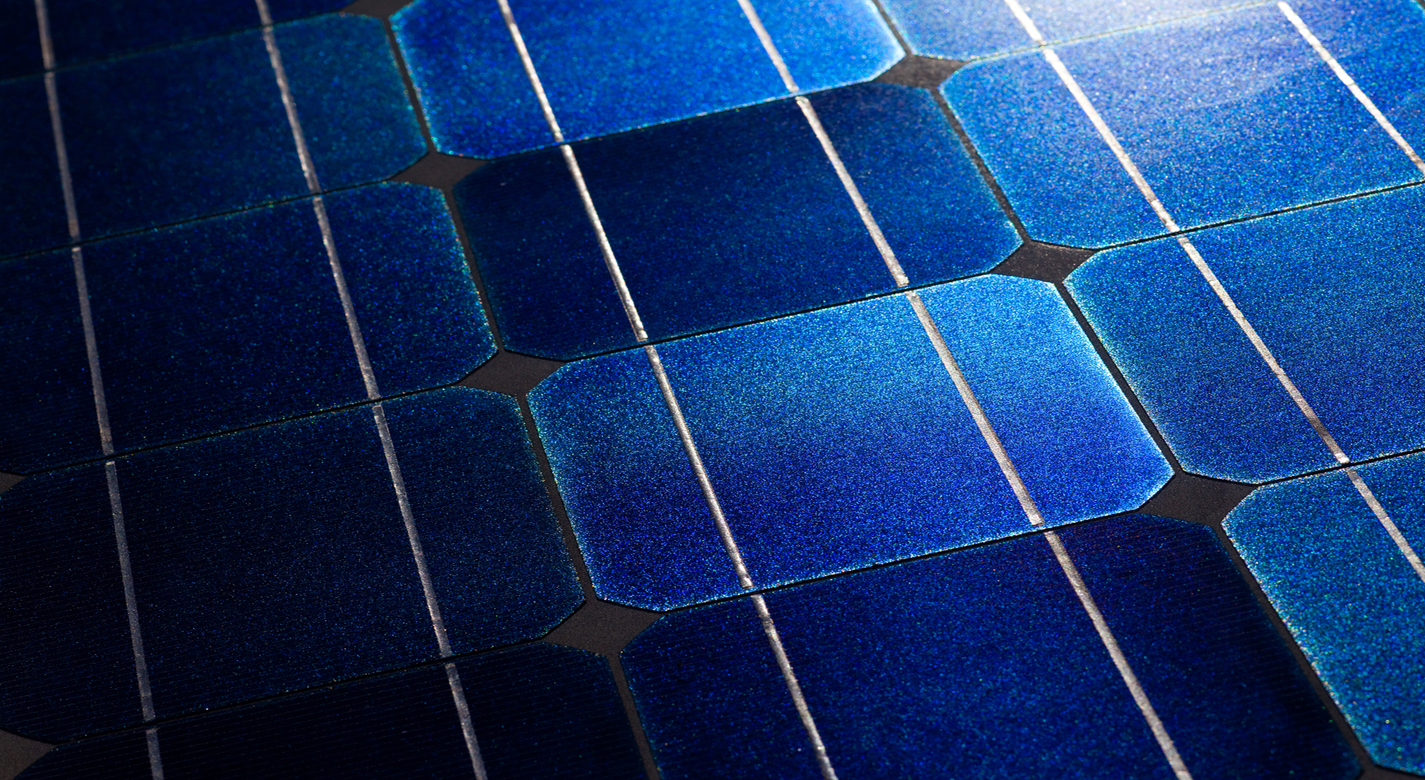Solar Powered Carbon Dioxide (CO2) Conversion
power generation and storage
Solar Powered Carbon Dioxide (CO2) Conversion (TOP2-160)
A low-cost nanomaterial thin-film device
Overview
NASA has developed a new technology that can convert the greenhouse gas carbon dioxide (C02) into fuel by using solar-powered, thin-film devices. Metal oxide thin films are fabricated to produce a photoelectrochemical cell that is powered by solar energy. By converting CO2 to fuel before it is emitted to the atmosphere this technology can mitigate the effects of the burning of fossil fuels, the worlds major fuel source for the foreseeable future This new nanomaterial thin-film device provides a low cost, facile fabrication pathway to commercialize the technology in the sustainable energy market. More importantly, it results in a zero carbon footprint by recycling C02 to fuels that are compatible with all existing fuel utilities. This is accomplished by using solar power to convert the C02 into a useable fuel in a very compact device.
The Technology
This technology consists of a photoelectrochemical cell composed of thin metal oxide films. It uses sunlight (primarily the ultraviolet (UV), visible and Infrared (IR) portions)) and inexpensive titanium dioxide composites to perform the reaction. The device can be used to capture carbon dioxide produced in industrial processes before it is emitted to the atmosphere and convert it to a useful fuel such as methane. These devices can be deployed to the commercial market with low manufacturing and materials costs. They can be made extremely compact and efficient and used in sensor and detector applications.


Benefits
- Efficient conversion of carbon dioxide
- High efficiency sustainable energy usage
- Inexpensive operations
- Versatile
- PV integrated device platform
- Reduced emissions
- Useful fuels produced
- Uses solar energy as the only power source
Applications
- Carbon capture technologies
- Photoelectrochemistry
- Automobile industry
- Materials Science
Similar Results

Solid State Carbon Dioxide (CO2) Sensor
The technology is a solid state, Carbon Dioxide (CO2) sensor configured for sensitive detection of CO2 having a concentration within the range of about 100 Parts per Million (ppm) and 10,000 ppm in both dry conditions and high humidity conditions (e.g., > 80% relative humidity). The solid state CO2 sensor achieves detection of high concentrations of CO2 without saturation and in both dynamic flow mode and static diffusion mode conditions. The composite sensing material comprises Oxidized Multi-Walled Carbon Nanotubes (O-MWCNT) and a metal oxide, for example O-MWCNT and iron oxide (Fe2O3) nanoparticles. The composite sensing material has an inherent resistance and corresponding conductivity that is chemically modulated as the level of CO2 increases. The CO2 gas molecules absorbed into the carbon nanotube composites cause charge-transfer and changes in the conductive pathway such that the conductivity of the composite sensing material is changed. This change in conductivity provides a sensor response for the CO2 detection. The solid state CO2 sensor is well suited for automated manufacturing using robotics and software controlled operations. The solid state CO2 sensor does not utilize consumable components or materials and does not require calibration as often as conventional CO2 sensors. Since the technology can be easily integrated into existing programmable electronic systems or hardware systems, the calibration of the CO2 sensor can be automated.

Gas Sensors Based on Coated and Doped Carbon Nanotubes
A typical sensor device includes a set of interdigitated microelectrodes fabricated by photolithography on silicon wafer or an electrically insulating substrate. In preparation for fabricating the SWCNT portion of such a sensor, a batch of treated (coated or doped) SWCNTs is dispersed in a solvent. The resulting suspension of SWCNTs is drop-deposited or injected onto the area containing the interdigitated electrodes. As the solvent evaporates, the SWCNTs form a mesh that connects the electrodes. The density of the SWCNTs in the mesh can be changed by varying the concentration of SWCNTs in the suspension and/or the amount of suspension dropped on the electrode area. To enable acquisition of measurements for comparison and to gain orthogonality in the sensor array, undoped SWCNTs can be similarly formed on another, identical set of interdigitated electrodes. Coating materials tested so far include chlorosulfonated polyethylene. Dopants that have been tested include Pd, Pt, Au, Cu and Rh nanoparticle clusters. To date, the sensor has been tested for NO2, NH3, CH4, Cl2, HCl, toluene, benzene, acetone, formaldehyde and nitrotoulene.

Advanced Efficiency Flexible Solar Film
By varying the number, type, orientation and functionality of various solar panel materials, a diverse family of devices can be constructed that can be tailored for many operational concepts. Various solar panel designs can be constructed that include active, cooling, and solar absorbance layers with tailored characteristics.
This flexibility is achieved by arranging multiple solar absorbance layers that are coupled to polymer composite solar absorbance layers. The polymer composite can contain metal salts, oxides and/or carbon nanotubes as needed for various applications. The polymer can be chosen for flexibility or stiffness characteristics as needed by the designer.
Configurations can include cooling layers with zinc oxides, indium oxides, and/or carbon nanotubes coupled between active layers. The carbon nanotubes can be aligned in a particular direction of the second cooling layer to achieve a heat flow bias. The cooling layer may be grooved to match other functional layers to increase the surface area for heat transfer.

Low-Temperature Oxidation/
Reduction Catalysts
The low-temperature oxidation catalyst technology employs a novel catalyst formulation, termed platinized tin oxide (Pt/SnOx). The catalysts can be used on silica gel and cordierite catalyst supports, and the latest developments provide sprayable formulations for use on a range of support types and shapes. Originally developed for removal of CO, the catalyst has also proven effective for removal of formaldehyde and other lightweight hydrocarbons.
NASA researchers have also extended the capability to include reduction of NOx as well as developed advanced chemistries that stabilized the catalyst for automotive catalytic converters via the engineered addition of other functional components. These catalyst formulations operate at elevated temperatures and have performed above the EPA exhaust standards for well beyond 25,000 miles. In addition, the catalyst can be used in diesel engines because of its ability to operate over an increased temperature range.
For use as a gas sensor, the technology takes advantage of the exothermic nature of the catalytic reaction to detect formaldehyde, CO, or hydrocarbons, with the heat being produced proportional to the amount of analyte present.

Carbon Dioxide Gas Sensors
Current bulk or thick film solid electrolyte CO2 sensors are expensive, difficult to batch fabricate, and large in size. In contrast, this new amperometric, solid-state, oxide-based electrolyte CO2 microsensor is affordable, easy to fabricate, and is so small that it could easily be integrated onto a substrate the size of a postage stamp.
The basic composition of the sensor is identical to a previously designed NASA Glenn technology in which a solid electrolyte of Na3Zr2Si2PO12 is deposited between interdigitated electrodes on an alumina substrate and is covered by Na2CO3/BaCO3. Unlike its predecessor, however, this innovation includes an additional layer of nanocrystalline SnO2 sol gel, an electron donor type (N-type) semiconductor, on top of the Na2CO3/BaCO3 . This new layer provides a greater number of electrons for reduction reaction at the working electrode to detect CO2. As a result, overall performance is enhanced, and this new state-of-the-art sensor has the ability to operate at temperatures as low as 375°C. This low temperature capability significantly decreases the amount of power required to operate the sensor, opening the door to a multitude of new applications that were previously unattainable.



